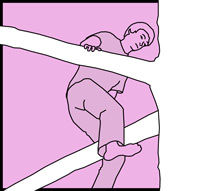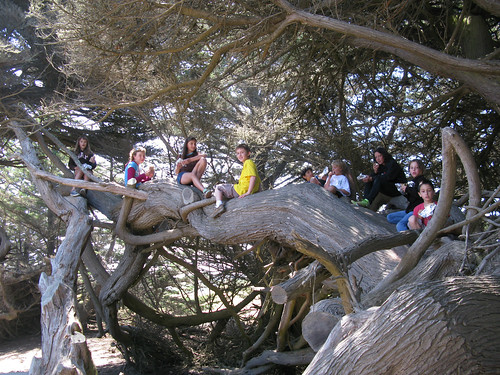Lately, I’ve come across a lot of discussions regarding kids climbing trees and whether or not parents should let them do it. People seem to fall into one of two camps when it comes to tree-climbing: Go For It, and Don’t Even Think About It. For the folks in the Don’t Even Think About It Camp, every tree is seen as a potential hazard – an accident waiting to happen – and many of the parents in the permissive camp are so conflicted about letting their kids climb trees that they can’t bear to watch. The contentiousness of the topic is clear from the number of parenting blogs that have, long, sometimes vociferous discussions about it.
In the Why section at the back of the book, I say that children experience a unique perspective and freedom when they can climb up and look out on the world from a new vantage point – excellent reasons to be sure, but more pragmatic reasons abound. Richard Louv, author of Last Child in the Woods: Saving Our Children From Nature-Deficit Disorder points out that positive experiences climbing trees help children have a strong positive connection with nature. Child development specialists observe heightened awareness and focus when children engage with natural climbing structures. When climbing trees, children learn to exercise judgement and self-restraint by choosing which route to take and how high to go.
But even “experts” are divided when it comes to talking about tree-climbing safety. In their “expert” opinions, your should or shouldn’t make the child wear a helmet when climbing a tree. Folks at the Bicycle Helmet Safety Institute say:
Children should not wear helmets on playgrounds or when climbing trees. The helmet can snag and the strap can asphyxiate them. Several deaths have been recorded, and more close calls.
and the folks at the Open Waldorf organization are working to define safe tree-climbing guidelines for all Waldorf schools that include helmets, harnesses, and climbing ropes. To back up their safety requirements they offer this fascinating pastiche of dire warnings and misconstrued statistics:
The Dangers of Unsafe Tree Climbing
According to the National Center for Policy Analysis, “unintentional injury is the top killer of children under 14, ahead of cancer and birth defects.”
- In the United States, more than 5,600 children die annually from unintentional injuries. (NCPA)
- Each year in the U.S., 140 children die, and 3 million more are injured in falls. (American Academy of Pediatrics)
- Falls are the second leading cause of death from unintentional injury in the U.S. (American Academy of Pediatrics)
- Being a timber cutter is the most dangerous job there is. (Bureau of Labor Statistics)
- Tree climbing is so unsafe, lumberjacks can’t buy life insurance. (Sierra Club)
- 36% of all hunting accidents in Georgia are caused by falling out of trees. (Sierra Club)
- A village in Zimbabwe is experiencing an epidemic of villagers falling out of trees. (Zimbabwe Daily News)
- Children of Ukrainian farmers often died falling out of trees.
- The majority of hunters are not injured by buckshot, but from falling out of trees. (Panama City News Herald)
- Playground equipment over 8 feet [has] close to three times the injury rate of equipment under that height. (National Program for Playground Safety)
- Professional tree climbing organizations such as Tree Climbers International do not recommend free climbing because it is so dangerous. They believe that encouraging a child to free-climb is life-threatening.
I can’t figure out where to start in on that, so I’ll just let it stand as it’s own example of fear-based thinking… No, I can’t. The American Academy of Pediatrics, in a 2006 report, states that helmets are contraindicated in playgrounds and tree-climbing activities due to the increased risk of strangulation. Also not in that report: any mention of the 140 unintentional deaths due to falls. Let’s put aside the fact that they are implying that all falls are related to tree climbing, but while we’re at it, what does 140 deaths in a population of almost 90,000,000 children mean? It means 0.00000156% of children per year – which makes tree-climbing safer than being driven to school.
No two children are alike and broad least-common denominator rules are never appropriate when it comes to evaluating the risk of an activity for your child. All children need opportunities to learn to judge and assess danger, as well as opportunities to demonstrate their ability to be responsible. They should practice climbing down as well as up, and learn to evaluate every branch. Tree climbing is a great activity for children (and adults) and it can be done safely without helmets or climbing ropes as long as everyone exercises a little common sense.
And I leave you with this wonderful quote from a spokesman for the Royal Society for the Prevention of Accidents in the UK:
Climbing trees and falling out of them is all part of growing up and having small injuries helps children learn about risks. We take the view that it’s a good thing to try to equip children and young people and help them make informed decisions about the risks that they take.








Pingback: Go Climb a Tree : Functional Fitness VA
Pingback: Did you used to climb trees? | Kindling Play and Training
Pingback: Monday thought of the week: a new vantage point |